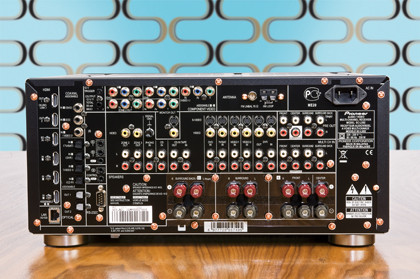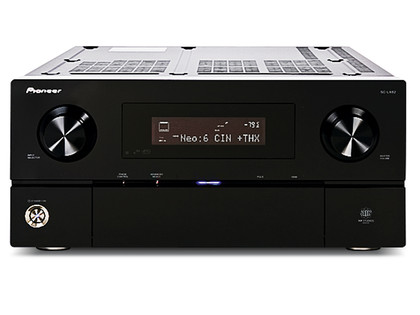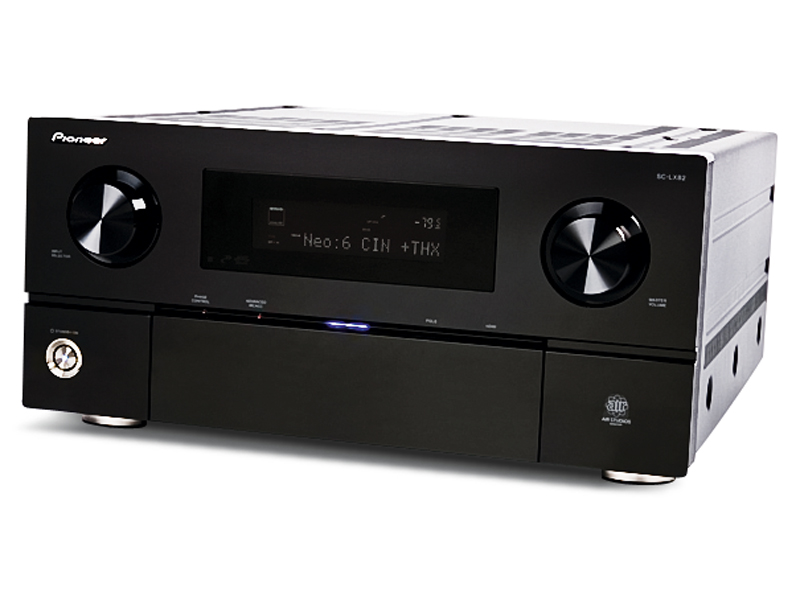TechRadar Verdict
The only reason this receiver has lost out is due to the competiton upping its game to new levels
Pros
- +
Punchy, highly detailed sound
- +
Brilliant features
- +
Looks fabulous
Cons
- -
No DPL IIz or Audyssey DSX
- -
No second remote
- -
Competition is getting tougher
Why you can trust TechRadar
Enter Pioneer's new SC-LX82. A radical upgrade with major updates, additional power, more features and extra pixie-dust – the LX82 certainly is not.
It was only earlier this year when I fell in love with Pioneer's ICEpower-fuelled SC-LX81. It was great-sounding, packed with features, relatively affordable and looked like a piece of modern art on the equipment rack. Unsurprisingly, it scooped the top amplifier gong at the 2009 HCC Best Buy awards.
But good R&D never sleeps – which is more than can be said for many of the Awards attendees the day after the event. In fact, the only obvious thing to change from the outside is the number on the badge and the addition of a front-mounted HDMI input.
Around the back the differences are only marginally more noticeable: one of the LX81's two AV in/out loops for a video recorder has been replaced in favour of Zone 2 and Zone 3 AV outputs; and gone is the phono-stage altogether.

WELL CONNECTED: The LX82 can cater for up to two further zones, by composite video or component, and analogue stereo outs or the surround back speaker terminals
I would say the latter was a sign of the times – had the vinyl market not been growing steadily for the last two years. But let's not decry the solid foundation upon which the SC-LX82 is built. This is a THX Ultra2 Plus specified amplifier with all the usual THX post-processing refinements.
It boasts sonic tuning in the UK by AIR Studios and has Pioneer's PQLS system for reclocking the multichannel audio signal over HDMI to reduce jitter with suitable (i.e. certain Pioneer) Blu-ray players.
The SC-LX82 also comes fitted with Pioneer's rather lush and accurate MCACC Room EQ system. Not only does this function handle all your setup and basic EQ functions, it incorporates a clever trickery to fine tune your room's standing waves, phase anomalies and reverb – the results of which are neatly displayed onscreen or exported to the MCACC software on your PC if you wish.
The MCACC system takes up a fair chunk of the gigantic manual and much of the best bits of Pioneer's GUI. Time may have made me over-familiar with this particular GUI, and I now find it quite reserved in comparison to some of the prettier interfaces. It's also slightly frustrating that not all features are accessed from a single main menu in-road.
For example, MCACC and system set-up is accessed through the main menu, but the audio parameters, video controls and internet radio menus are all accessed with different keys on the remote. I'm sure once you have used the LX82 for a while it won't be an issue – but it seems to be unnecessarily complex in this respect.
Ice to see you
In case the growing cornucopia of cracking Blu-ray releases has kept you from following all that is moving and shaking in home cinema, Pioneer took a bold step in introducing iCepower modules into the elite, performance-driven end of the av market last year.

HIDDEN LEGENDS: Most of the Pioneer's legends, including the THX Ultra2 Plus badge, are on the top of the unit. Boo!
These are digital Class-D amplifier modules developed by Bang & Olufsen, which have been widely adopted for AV amps and subwoofers due to their high power output, low current draw and incredibly linear output. Some implementations have been dire and some have been outstanding – Pioneer's offerings falling firmly into the latter category.
Supported by Pioneer's own substantial power supply, the sound is clean, potent and wonderfully crisp without harshness. Bass digs deep without any bloom or excess, and low-bass to the main channels leaps positively gazelle-like out of the speakers.
Much of this cleanliness is due in no small way to the MCACC EQ system doing its thing. Set up in 'Full-Auto' mode (which is a wonderful phrase that follows 'Uzi nine-millimetre' in an Austrian accent so well...), the LX82 managed a very-close-to-verbatim set of room measurements to the LX81.
Whether the small discrepancies were down to the extra 30-or-so Blu-ray platters on the shelf since February or the extra Summer-holiday muffin around my waistline is a moot point – because it still sounds superb.
With Pioneer's AVR taking the reins, the breathtaking carnival scene in the Blu-ray release of Ghost In The Shell 2: Innocence simply explodes out of the speakers with amazing projection and clarity – although initially the sound feels a little forward because the Pioneer has stripped away so much mid-range bloom and bass thickness.
The high-pitched massed choral singing of GitS' soundtrack is rendered every bit as eerie and captivating as the film's video content, while the sonic ambience of the tall cityscape in which the procession marches is tangible.
When the bass drum kicks in, the punch and speed of attack is superb; there isn't a hint of over-egging the LF to add artificial weight to the sound, although the sheer pace puts an incredible demand on the main speakers and the subwoofer. If you own an old-school small driver/ported cabinet sub, the SC-LX82 will eat it alive.
With movies of a more gung-ho nature (with no mentions of Confucius), I found the Pioneer can sound just a little bit reserved compared to some of the more spunky amplifiers out there. Big explosions are incredibly detailed and perhaps the most accurately rendered of the sub £2K amplifier bunch, but there are times when you need a film's soundtrack to bypass all pretences of sophistication, grab you by the cajones and drag you along for a joyride.
The LX82 gets oh-so-close to this excitement level, but I can't help thinking the Pioneer's idea of a joyride is more Gran Turismo than Grand Theft Auto. That said, it is chaos-filled action-packed scenes where the LX82's resolution really comes into its own. It conveys every last sonic detail the director intended.
I noticed this trait with the LX81 through the dock battle scene in Matrix Revolutions (Blu-ray) and the LX82 is every bit as electrifying. Again, the rush of the Squidies and the APU's heavy machine guns are delivered with astonishing transient power. The blast of each shot is picked out in a maelstrom of aural armageddon.
Whack up the volume and the room simply fills with sculpted sonic chaos. The beast does quiet scenes just as well and dialogue projects out with all the emotion and inflection that the actors can muster.
The gruff baritone voice of Batou in GitS is perhaps not quite as deep or fulsome as some of the competitor's AV receivers, but it is remarkably precise and accurate. In fact, that dichotomy sums up the sound of the LX82.
While it doesn't have the warmth or sheer mid-bass body of some of its competitors, this perceived lack of 'richness' lets the rest of the sound breathe like never before.
Tough competition
Of course, all this is close to precisely what I said of the SC-LX81, because it and the LX82 are essentially one and the same thing. Another barn-storming, award-winning Best Buy product for sure then? Not necessarily...
Pioneer's peers, you see, have moved on. Most now come with two remote controls so you have a spare one to let loose in Zone 2, and many have added new features such as Dolby ProLogic IIz, Audyssey DSX and, in Onkyo's case, an extra two channels of power to make the most of both new formats.
The SC-LX82 is still a great act and you will not be disappointed with its performance, but it simply isn't as far ahead of the £2K competition as its forebear.
Follow TechRadar Reviews on Twitter: http://twitter.com/techradarreview
